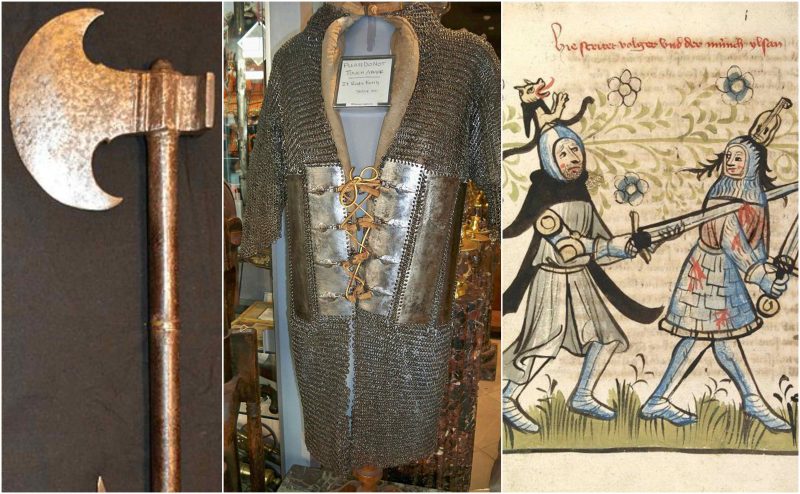The Romans described the civilizations that lived beyond their borders as savage “barbarians,” but these ancient tribes were anything but primitive.
The leaders of groups such as the Goths, Celts, Huns, and Vandals were often brilliant military tacticians, and their craftsmen were capable of fashioning advanced arms and military technology ranging from blades and bows to siege weapons. Take a closer look at six of the weapons the warrior tribes used to take on the might of the Roman Empire:
The Battle-Axe
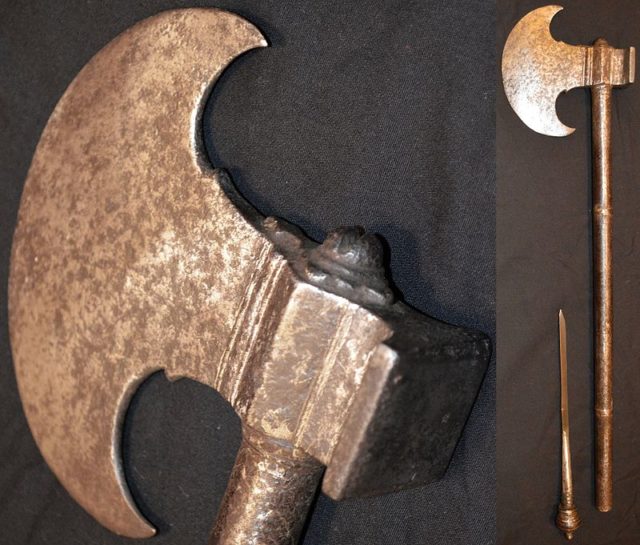
Few barbarian weapons inspired more horror than the axe. While most tribal warriors carried spears or swords into combat, Germanic soldiers were known to wield heavy battle-axes capable of smashing through the shield, armor, and helmet in a single blow.
The Franks, meanwhile, were partial to a lightweight axe known as a “francisca,” which could be used as a hacking weapon or hurled at close range as a projectile. “The iron head of this weapon was thick and exceedingly sharp on both sides while wooden handle was very short,” the historian Procopius wrote of the francisca in the sixth century A.D. “And they are accustomed always to throw these axes at one signal in the first charge and shatter the shields of the enemy and kill the men.”
The axe was one of the many barbarian weapons that carried over into the medieval world. It became the signature weapon of the Varangian Guard, a band of Viking mercenaries who served as bodyguards for the Byzantine emperors of the 10th and 11th centuries.
The Long Sword

The double-edged long sword was the favored weapon of the Gauls, a collection of Celtic tribal peoples who inhabited France, Belgium, and Western Germany. Unlike the shorter Roman “gladius,” which was principally a stabbing weapon, the iron swords employed by the Gauls were designed to hack and slash at the enemy in a downward stroke resembling an axe-blow.
The swords tended to be less useful on packed battlefields where there was not as much room to maneuver, but they were especially deadly in individual and guerilla combat—the barbarians’ preferred tactics. The long sword figured prominently in the many wars fought between the Gauls and the Roman Republic.
When the Gallic chieftain Brennus invaded Italy in the fourth century B.C., his troops famously used their sabers to cut through enemy shields and rout a Roman army along the River Allia. They went on to carry out a grisly sack of the city of Rome.
Chainmail
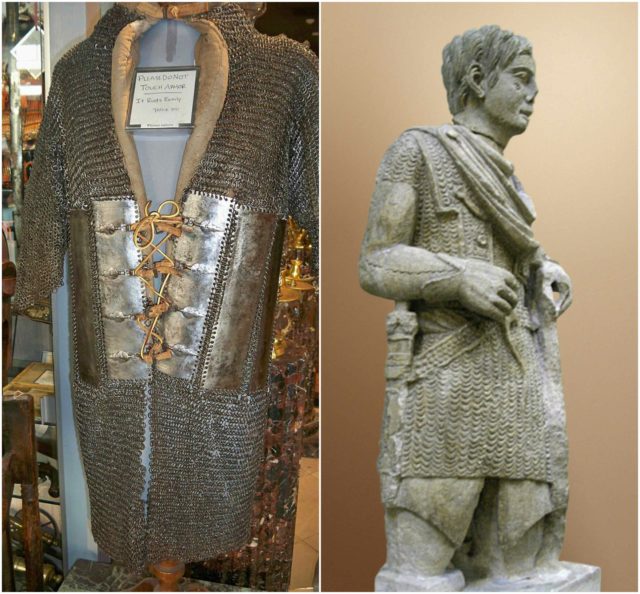
Mail is a type of armor consisting of small metal rings linked together in a pattern to form a mesh. A coat of this armor is often referred to as a hauberk. The earliest example of surviving mail was found in a Dacian chieftain’s tomb in Ciumești, Romania.
Its invention is commonly credited to the Celts, but there are examples of Etruscan pattern mail dating from at least the 4th century BC. Mail may have been inspired by the much earlier scale armor.
The use of mail armor soon spread across North Africa, the Middle East, Central Asia, India, Tibet, South East Asia, and Japan.
Among the most effective types was chainmail, which may have been invented in Europe by the Gallic Celts in the third century B.C. Most Gallic armor took the form of a short-sleeved shirt or vest made from an interlocking mesh of small metal rings.
This provided flexibility while also protecting the wearer from slashing blows by swords and daggers, which would glance off its hard outer surface.
The Celtic Chariot
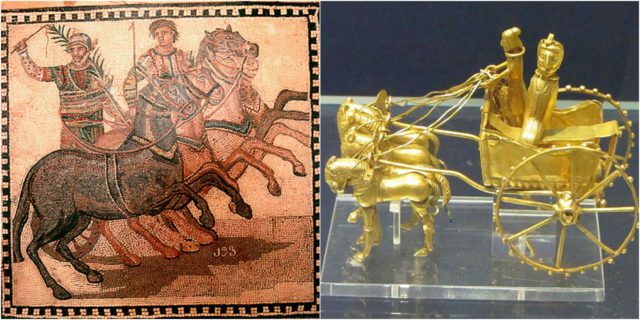
During his campaigns in Britain in 55 and 54 B.C., Julius Caesar became the first Roman general to encounter the war chariots of the native Celtic tribes. These vehicles were usually drawn by two horses, sporting iron-rimmed wheels and sturdy platforms made of wicker and wood.
In combat, they functioned as a kind of ancient personnel carrier: drivers would drop a lone warrior near the fighting, race to safety and then return to pick the soldier up if he was injured or needed to withdraw.
“They drive about in all directions and throw their weapons and generally break the ranks of the enemy with the very dread of their horses and the noise of their wheels,” Caesar wrote, “and when they have worked themselves in between the troops of horse, leap from their chariots and engage on foot.”
The British chariot later took a starring role in the 60 A.D. revolt of the warrior queen Boudica, who united several native tribes against the Romans. While she succeeded in razing three Roman Briton cities, her war charioteers were eventually hemmed in and slaughtered at the Battle of Watling Street.
The Falcata

The falcata is a type of sword typical of the pre-Roman Iberian Peninsula (modern Spain and Portugal). The falcata was used to great effect by the armies of Carthage in their wars against Rome.
The falcata has a single-edged blade that pitches forward towards the point, the edge being concave near the hilt, but convex near the point.
This shape distributes the weight in such a way that the falcata is capable of delivering a blow with the momentum of an axe while maintaining the longer cutting edge of a sword.
The grip is typically hook-shaped, the end often stylized in the shape of a horse or a bird.
There is often a thin chain connecting the hooked butt of the Iberian with the hilt. Although usually a single-edged weapon, examples of double-edged falcata have also been found.
The falcata was derived from the sickle-shaped knives of the Iron Age; that too explains their ritual uses. It is thought to have been introduced in the Iberian Peninsula by the Celts, who pioneered iron-working in the region.
The Recurve Bow
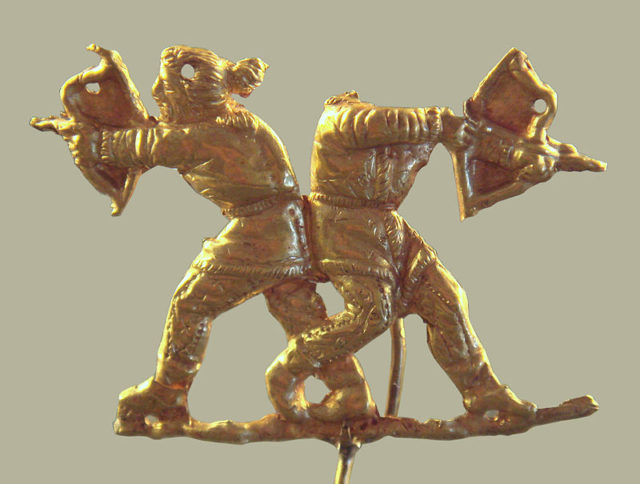
In the fifth century A.D., Attila and his Hunnic steppe-warriors invaded Europe from the East and cut a bloody swath across the Roman Empire. The “Scourge of God” and his Huns shocked Westerners with their maneuverable cavalry and hit-and-run tactics, but they also possessed a formidable new weapon: the recurve bow.
Hun horse archers were famed for their ability to fire their bows accurately even while at a full gallop. In battle, they often ambushed their adversaries in scattered bands, unleashing devastating hails of arrows before riding back to safety. Once the enemy was weakened, the Huns would swarm them at close range and finish the job with spears, sabers, and even lassos.
Perhaps the most ancient written record of the use of recurved bows is found Psalm 78:57 (“They were turned aside like a deceitful bow” KJV), which is dated by most scholars to the eighth century BC. Adam Clarke points out that “If a person, who is unskillful or weak, attempt to recurve and string one of these bows, if he takes not great heed, it will spring back, and regain its quiescent position; and, perhaps, break his arm.
